Abstract
The B building sector contributes to 40% of the carbon emissions in the atmosphere. Several studies show that high-performance MAN (Madrasah Aliyah Negeri) buildings contribute to reducing carbon emissions. This study discusses the evaluation of natural lighting in educational buildings, namely the MAN (Madrasah Aliyah Negeri) Cimahi building. This research was conducted using direct survey methods via measuring and simulating the natural lighting using Sefaira. The simulation results show that natural lighting in the building does not meet lumination standards. This article concludes that the addition of a roof overhang, windowed areas, façade elements, and shading strategies are all factors that can affect natural lighting in the MAN (Madrasah Aliyah Negeri) Cimahi building.
1. Introduction
Global warming is increasing and impacting the environment. In Indonesia, the year with the largest anomaly, of 0.8 °C, was 2016, released by the BKMG (Badan Meteorologi, Klimatologi, dan Geofisika). According to the EECCHI (Energy Efficiency and Conservation Clearing House Indonesia) in 2012, the building sector contributes to 40% of the carbon emissions to the atmosphere. Efforts to help reduce gas emissions can be carried out for high-performance MAN (Madrasah Aliyah Negeri) buildings via the use of technology [1]. The designs of educational buildings need to take into account their use of energy and the comfort of their users. Moreover, the comfort of these spaces must be considered in relation to the delivery of knowledge through visuals and sounds that occur in the rooms [2].
One of the educational facilities that has problems regarding the thermal comfort of its users is the MAN (Madrasah Aliyah Negeri) Kota Cimahi. Efforts towards energy efficiency in buildings can be made through the maximization of natural lighting, shading, ventilation, thermal mass, solar air preheating, windows, air filtration, and passive solar heating [3].
Sefaira is an analysis software in buildings that can calculate four main components, namely energy, natural lighting, thermal, and HVAC (Heating, Ventilation, and Air-Conditioning) systems. Calculation of the natural and thermal lighting in educational buildings is necessary to find out the comfort of the buildings in connection to their lighting and thermals, and provide recommendations for their design or MAN (Madrasah Aliyah Negeri) managerial improvements regarding user habits.
2. Materials and Methods
Natural lighting is lighting obtained from direct sunlight, and this light is obtained in the morning to evening [4]. Based on the SNI (Indonesian National Standard) 03-2396-2000, natural lighting is said to be good between 8.00 WIB (Western Indonesian Time) and 16.00 WIB (Western Indonesian Time). Thermal comfort is a thermal condition that is perceived by humans in the MAN (Madrasah Aliyah Negeri), but conditioned by the environment and objects in the thermal environment around them [5]. Thermal comfort is closely related to natural conditions, but can be improved and minimized with architecture [6]. Natural lighting is influenced by windows and their orientation regarding the direction of the sun [7]. The bigger the window, the more likely the room will be exposed to sunlight; but this also increases the indoor temperature. Therefore, there is a standard for the optimum lux quantity in the room.
2.1. Types of Research
The type of research carried out used quantitative research methods via conducting a field survey, then conducting a simulation process through the Sefaira software, so as to obtain the data needed to address the researched cases.
2.2. Research Location
The research was conducted at the MAN (Madrasah Aliyah Negeri) Kota Cimahi, located in Leuwigajah, Cimahi, Indonesia (Figure 1). This location was chosen based on field surveys and interviews with users.
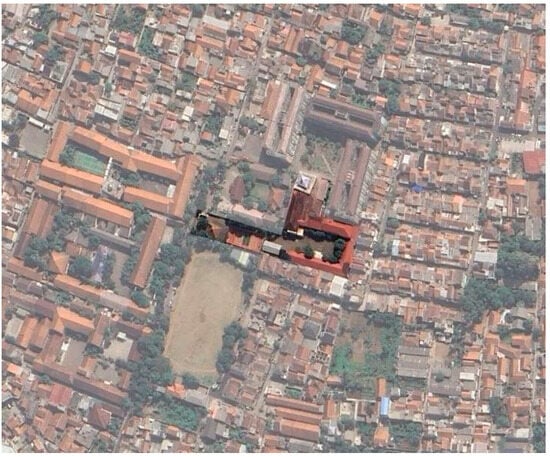
Figure 1.
Studied educational building located by Google Maps.
2.3. Data Collection Techniques
Data collection was carried out into two stages, namely:
- Primary data, collected by conducting field surveys.
- Secondary data, obtained through the literature study method for use as a reference for standardization and research support.
2.4. Technical Data Analysis
After obtaining the field data, an analysis was carried out and matched with existing standards. Here are the steps:
- Conducting simulations to obtain thermal comfort data through the Sefaira software for SketchUp 2023.
- Comparison with existing standards to obtain a conclusion on whether the building is appropriate or requires improvements.
3. Results and Discussion
The MAN (Madrasah Aliyah Negeri) Kota Cimahi building has a centralized building orientation with one two-story building and one one-story building. The master plan of the building can be seen in Figure 2. The building material uses red brick walls, windows with an aluminum frame and 5 mm float glass, as well as a saddle-shaped tile roof.
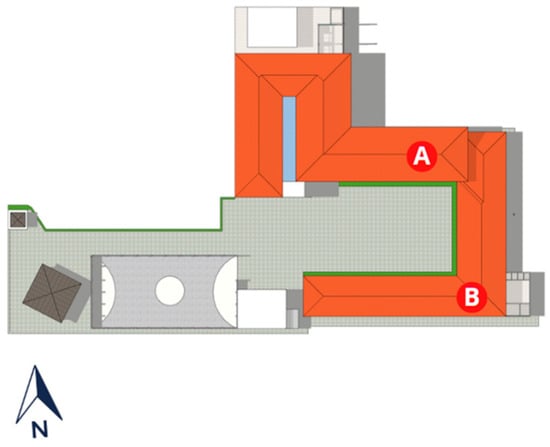
Figure 2.
Master plan obtained via field survey.
The lux standard for classrooms, according to the SNI (Indonesian National Standard), is 250–300 lux [8]. Some spaces have fairly large window dimensions, so the room is quite exposed to sunlight (Figure 3). This leads to an increase in room temperature and discomfort due to overheating, which can be seen in Figure 4. There are also some buildings that are less exposed to sunlight (Figure 5), so they are humid, especially the space in the south building at the east end, which can be seen in Figure 6.
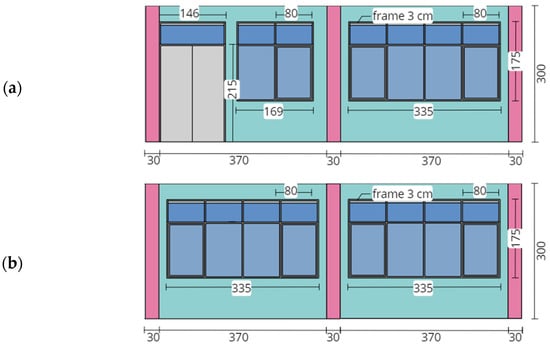
Figure 3.
(a) Dimensions of the south-side windows of sample A, obtained via SketchUp. (b) Dimensions of the north-side windows of sample A, obtained via SketchUp.
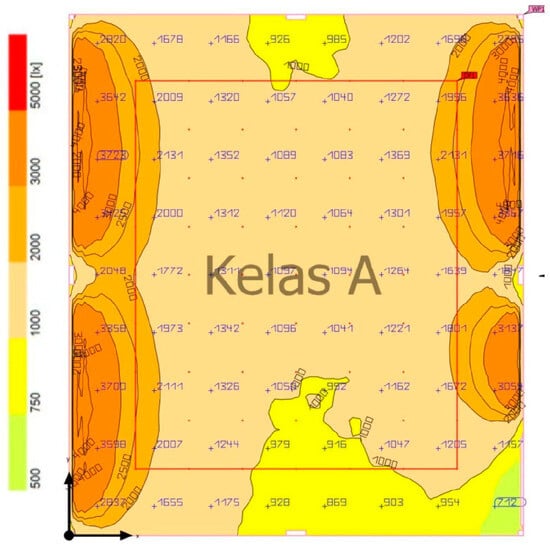
Figure 4.
Sample A (classroom with a large window, lux 7310) obtained via Dialux Evo 9.2.
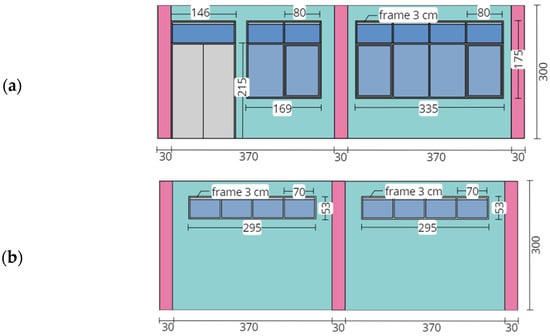
Figure 5.
(a) Dimensions of the north-side openings windows of sample B, obtained via SketchUp. (b) Dimensions of the south-side openings windows of sample B, obtained via SketchUp.
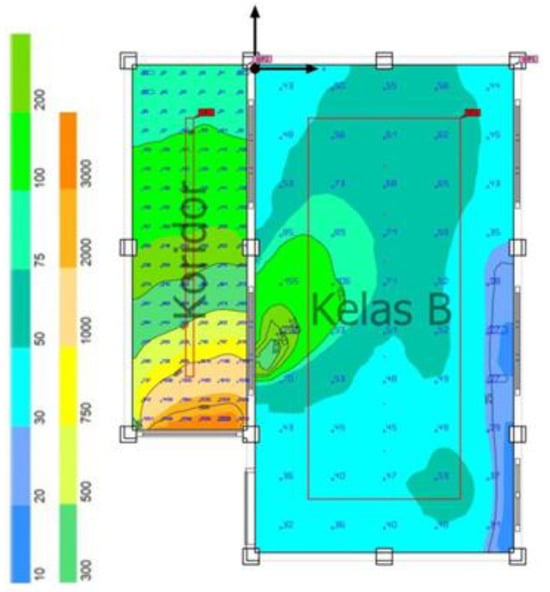
Figure 6.
Sample B (classroom with less lighting, lux 76) obtained via Dialux Evo 9.2.
In addition to analyzing the natural lighting using Dialux Evo 9.2, this study also used analysis via Sefaira to analyze the existing plan (Figure 7) to find out whether the spaces in the building were in accordance with the standards or not. And the results mostly showed that the space in the building does not have good enough natural lighting (Figure 7).

Figure 7.
(a) Natural lighting analysis of the existing first floor. (b) Natural lighting analysis of the existing second floor. (c) Simulation results.
Based on the data obtained from the analysis above, there are several solutions that can be applied regarding changing the material of the window glass, adjusting the shape and dimensions of the window according to the standards and their requirements, and adding elements such as cantilever windows. After making changes and adding windows, a Sefaira software simulation was carried out again and the results of the natural lighting and thermal comfort in the MAN (Madrasah Aliyah Negeri) Kota Cimahi building were better than before (Figure 8). Then, the simulation results show improvements in the quality of natural lighting which can be seen in Figure 9.
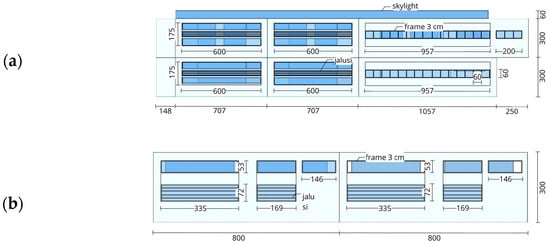
Figure 8.
(a) Additions to and resizing of the west building windows. (b) Additions to and resizing of the south building windows.

Figure 9.
(a) Natural lighting analysis of the first floor after treatment. (b) Natural lighting analysis of the second floor after treatment. (c) Simulation results.
4. Conclusions
From the data and analysis results regarding natural lighting and thermal comfort in the MAN (Madrasah Aliyah Negeri) Kota Cimahi, it can be concluded that the dimensions, materials, shapes, and elements of the windows affect the amount of sunlight exposure in the room. It can be concluded that natural lighting affects the living quality of the space. Too much sun exposure makes the room temperature too hot, so there are standards regarding the optimal amount of lux in the room. With the optimization of natural lighting, buildings can reduce their use of electrical energy and air-conditioning.
The MAN (Madrasah Aliyah Negeri) Kota Cimahi building has several classrooms that do not meet the thermal comfort standards based on the amount of lux in the space; there are rooms that are too bright and hot, and there are also rooms that are too dark and humid. Therefore, windows should be added and treatment given in the form of material replacements and cantilever windows.
Supplementary Materials
The following are available online at https://www.mdpi.com/article/10.3390/IOCBD2023-15211/s1.
Author Contributions
Conceptualization, Methodology, Software, Visualization, Original draft preparation: H.A., L.H. and S.T.; Methodology, formal analysis: H.A., L.H., S.T. and B.P.; Validation, writing—review and editing, supervision, funding: B.P. All authors have read and agreed to the published version of the manuscript.
Funding
This research was funded by BeCool Indonesia.
Institutional Review Board Statement
Not applicable.
Informed Consent Statement
Not applicable.
Data Availability Statement
The data presented in this study are openly available in https://www.researchgate.net/publication/376072861_Natural_Lighting_Evaluation_of_the_Madrasah_Aliyah_Negeri_Cimahi_as_an_Educational_Building_in_Indonesia_Using_Sefaira_Software at DOI: 10.13140/RG.2.2.33125.58081.
Acknowledgments
This article was supported by the Center of Excellence for Low Emission Building Materials and Energy, and the Laboratory of Science, Technology and Building Materials of the Universitas Pendidikan Indonesia.
Conflicts of Interest
The authors declare no conflict of interest.
References
- Salsabila, F.; Prianto, E. Aplikasi dan Evaluasi Dengan Software EDGE pada Bangunan Dekanat Baru Fakultas Teknik Universitas Diponegoro. IMAJI 2020, 9, 691–700. [Google Scholar]
- Idrus, I. Model Pencahayaan Alami Ruang Kelas Berbasis Persepsi Visual Siswa Sekolah Dasar dan Menengah di Daerah Tropis. Ph.D. Thesis, Universitas Hasanuddin, Kota Makassar, Indonesia, 2020. [Google Scholar]
- Szokolay, S.V. Introduction to Architectural Science the Basis of Sustainable Design; Architectural Press: Oxford, UK, 2004; p. 17. [Google Scholar]
- Nurhaiza; Lisa, N.P. Optimasi Pencahayaan Alami pada Ruang. Arsitekno 2016, 7, 32–40. [Google Scholar]
- Gosal, P.H.; Makarau, V.H. Optimalisasi Kenyamanan Termal Pada Rumah-Rumah Kayu di Kampung Jawa Tondano. Front. J. Sains Dan Teknol. 2018, 1, 91–104. [Google Scholar]
- Snyder, J.M. Election Goals and the Allocation of Campaign Resources. Econom. J. Econom. Soc. 1989, 57, 637–660. [Google Scholar] [CrossRef]
- Ching, F.D.K. Arsitektur, Bentuk, Ruang, dan Susunannya; Erlangga: Jakarta, Indonesia, 1999. [Google Scholar]
- Badan Standardisasi Nasional. Available online: http://sispk.bsn.go.id/SNI/DetailSNI/13243 (accessed on 20 September 2023).
Disclaimer/Publisher’s Note: The statements, opinions and data contained in all publications are solely those of the individual author(s) and contributor(s) and not of MDPI and/or the editor(s). MDPI and/or the editor(s) disclaim responsibility for any injury to people or property resulting from any ideas, methods, instructions or products referred to in the content. |
© 2023 by the authors. Licensee MDPI, Basel, Switzerland. This article is an open access article distributed under the terms and conditions of the Creative Commons Attribution (CC BY) license (https://creativecommons.org/licenses/by/4.0/).